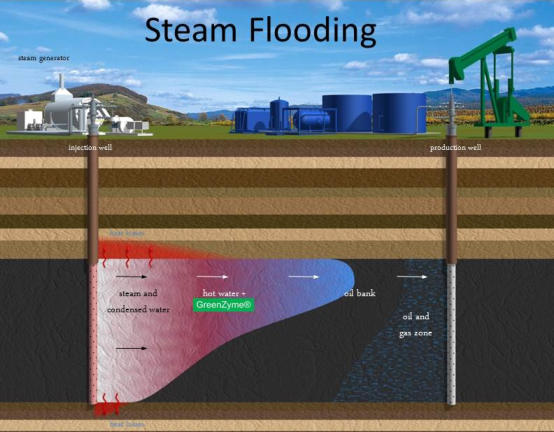













“Improved Oil Recovery & EOR using Biological Enzymes”
info@btprocessing.com
Enzyme enhanced oil recovery (EEOR) for cyclic steam injection
(extract)
Patent Application number: 20080115945 Issued: May 22, 2008 GREENZYME® has the effect of increasing the mobility of the oil by reducing surface tension, decreasing contact angles and preventing crude oil that has become less viscous by heating or other means, from re-adhering to itself as it cools. GREENZYME® is active in water and acts catalytically in contacting and releasing oil from solid surfaces. GREENZYME® is effective up to 270 degrees Celsius in liquid phase under pressure and is not restricted by variations in the American Petroleum Institute (API) specific gravity ratings of the crude oil. GREENZYME® is not a live microbe and does not require nutrients or ingest oil. GREENZYME® does not trigger any other downhole mechanisms, except to release oil from the solid substrates. (ie: one function). The cyclic steam and enzyme system is comprised of four (4) stages. The first stage is pre-treatment followed by a steam injection stage , a period of idle process known as the soak stage followed by the recovery stage . This cyclic steam and enzyme system is sequential and repeated whenever recovery volumes diminish to a calculated economic break-even point. In the stage of pre-treatment , an enzyme composition such as GREENZYME® and described above, is diluted to become a diluted enzymatic fluid and sent to a heater to have the temperature of the diluted enzymatic fluid increased to between 80 to 90 degrees Celsius. The heated diluted enzymatic fluid is then transferred to an enzyme pump . Alternatively, diluted enzymatic fluid may be transferred directly to the enzyme pump bypassing the heater. A sufficient volume of the diluted enzymatic fluid [115] or heated diluted enzymatic fluid is then pumped through an injection pipe through the downhole well bore and into the oil well formation so as to contact a desirable amount of residual oil particles. The stage of pre-treatment may last from 0-4 weeks before commencing the steam injection stage. During the stage of pre-treatment the diluted GREENZYME® fluid or heated diluted enzymatic fluid acts to release the oil from solid surfaces, increase the mobility of the oil by reducing surface tension, decreasing contact angles, preventing crude oil that has become less viscous by heating or other means, from re-adhering to itself as it cools and acts catalytically in contacting and releasing oil from solid surfaces. Blockages in the oil well formation may be reduced or eliminated as well. In the steam injection stage, a steam generator combines heat and water to form steam. Steam is then transferred to a steam/vapor pump where it is then pumped down an injection pipe, which may be the same as or different from the one used by the enzyme pump, through the downhole well bore and into the oil well formation. Steam then loses its heat into the oil well formation warming the oil particles and the surrounding area oil well formation to a sufficient temperature to cause the oil particles to become less viscous. The steam also acts to disperse the diluted enzymatic fluid or heated diluted enzymatic fluid further into the oil well formation to further contact oil particles thereby increasing contact volume. The heat available to be transferred to the oil well formation and oil particles reacts over a period of time while the well sits idle. The soak stage as it is known, allows the heat to permeate the oil well formation and the diluted enzymatic fluid or heated diluted enzymatic fluid to reach maximum oil releasing efficiency. The diluted enzymatic fluid or heated diluted enzymatic fluid remains active in water or hot water included condensed steam and acts catalytically in contacting and releasing oil from solid surfaces. It is not restricted by variations in the American Petroleum Institute (API) specific gravity ratings of the crude oil. The soak stage lasts between 0-30 days depending on the type and size of the oil well formation. Following the soak stage is the recovery stage in which an extraction pump is connected to the oil well formation via a retrieval pipe and an uphole well bore. In the recovery stage, the extraction pump is activated causing the oil particles to be transferred from the oil well formation through the uphole well bore and retrieval pipe to be transferred for refining.







